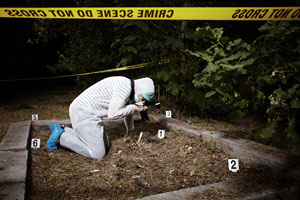Several experts were among the nearly 100 witnesses who testified for the prosecution in the quadruple murder trial of Kyle Flack in Franklin County, Kansas. While most of the experts provided the kind of medical and forensic testimony that is common to homicide prosecutions, one witness — an entomologist — testified in a field of expertise that less often plays a role in criminal trials.
Four Deaths
Flack was charged with murdering four people with a shotgun, including an 18-month-old girl. Two of the charges carry the potential for the death penalty.
According to prosecutors, Kaylie Bailey left her home with her 18-month-old daughter on the morning of May 1, 2013. Receipts and financial records established that she withdrew money from a bank, bought gas for her car, and purchased cheeseburgers and a kid’s meal from Burger King.
Bailey’s mother testified that she saw Bailey on the morning on May 1 and that Bailey planned to leave her daughter at the home of her boyfriend, Andrew Stout, while she went to work. Stout was also working but Bailey was apparently relying on Flack, who was staying with Stout, to watch her daughter.
Bailey was due at work at 11:00 p.m., but she did not appear. On May 3, Bailey’s employer reported her missing. That same day, Stout’s sister became concerned about her inability to contact Stout. She went inside Stout’s home and, since it was raining, closed the windows. She noticed a bad smell but did not see anything unusual in the home. The rooms were disordered but the house was typically messy. Police conducted four welfare checks in response to the missing persons reports, but they did not find anything amiss.
A few days later, a friend who was feeding Stout’s pets saw what appeared to be a hand when he peered through a crack in the cinder blocks of an outbuilding. Police discovered the body of Stout’s roommate beneath a tarp in the outbuilding. When they searched the home, they found the bodies of Stout and Bailey beneath a large pile of clothing in the master bedroom. Bailey’s arms were bound behind her back.
Prosecutors maintain that Bailey must have died on May 1 because her body was dressed in the same clothing she was wearing when her image was recorded on the bank’s surveillance video. A kid’s meal wrapper from Burger King was also found in the home’s kitchen.
On May 11, a sheriff’s deputy spotted a suitcase floating in an Osage County creek. The body of Bailey’s daughter was found inside the suitcase.
Experts Testify for Prosecution
The prosecution relied on the testimony of a number of experts to make their case against Flack. A forensic pathologist testified that Stout was shot five times. The roommate was shot twice while Bailey and her daughter were each shot once. The pathologist testified that they were all killed with a shotgun.
A firearms examiner linked at least eight of the nine shotgun shells recovered at the crime scene to a partial pump-action shotgun that was recovered from a garbage dump. Witnesses testified that Flack took a pump-action shotgun with him wherever he went.
Only the shotgun’s receiver and magazine were found in the dump. The firearms examiner testified that he “simulated” the barrel and stock by using inventory from the crime lab. Cross-examination of the expert focused on whether examining a “simulation” of a weapon, rather than a complete weapon, can produce an accurate result. The cross-examination also revealed that the first firearms examiner who studied the weapon concluded that the shells found at the scene could not have fired from the receiver that was recovered from the dump. The second examiner testified that the first examiner later withdrew that conclusion.
A forensic scientist specializing in DNA analysis testified that a few of Flack’s DNA markers were present on the receiver that was found in the dump. Other markers belonged to the victims or to dump employees who found the receiver. Two markers could not be identified.
Entomologist Determines Time of Death
In addition to the other forensic experts who helped reconstruct the crime, prosecutors turned to an entomologist. Stout’s body had substantially decomposed and partially mummified before it was found. The body was sitting upright near a heat vent. The warm environment attracted flies that laid eggs on the body’s face. When the body was discovered, it was covered with more than 100,000 maggots. Some of the skin on the face had been eaten away.
Neal Haskell, an international forensic entomologist consultant, used the temperature in the room and the nature of the insects (blow fly larvae) to determine an approximate time of death. He testified that Stout died between April 28 and April 30. Haskell testified that Bailey probably died between May 2 and May 5, although he agreed with the prosecutor’s suggestion that she might have died on May 1.
A forensic scientist specializing in bloodstain pattern analysis testified that the roommate’s body had been moved after he was killed. Based on samples collected from the roommate’s brain, Haskell testified that the roommate died between April 18 and April 20.
Guilty Verdict
Flack called no witnesses. After just three hours of deliberation, the jury found Flack guilty of all four murders. The trial will next proceed to the penalty phase, during which the jury will consider evidence in support of and in opposition to the prosecution’s request for the death penalty.
Haskell’s time-of-death evidence may be important to that determination. If all four victims had been killed at the same time, Flack would be in a position to argue that he acted in the heat of the moment. The time-of-death evidence suggests that Flack made deliberate decisions, in some instances separated by days, to kill each of the four victims. The jury may take that evidence into account when it decides whether the death penalty is warranted.




